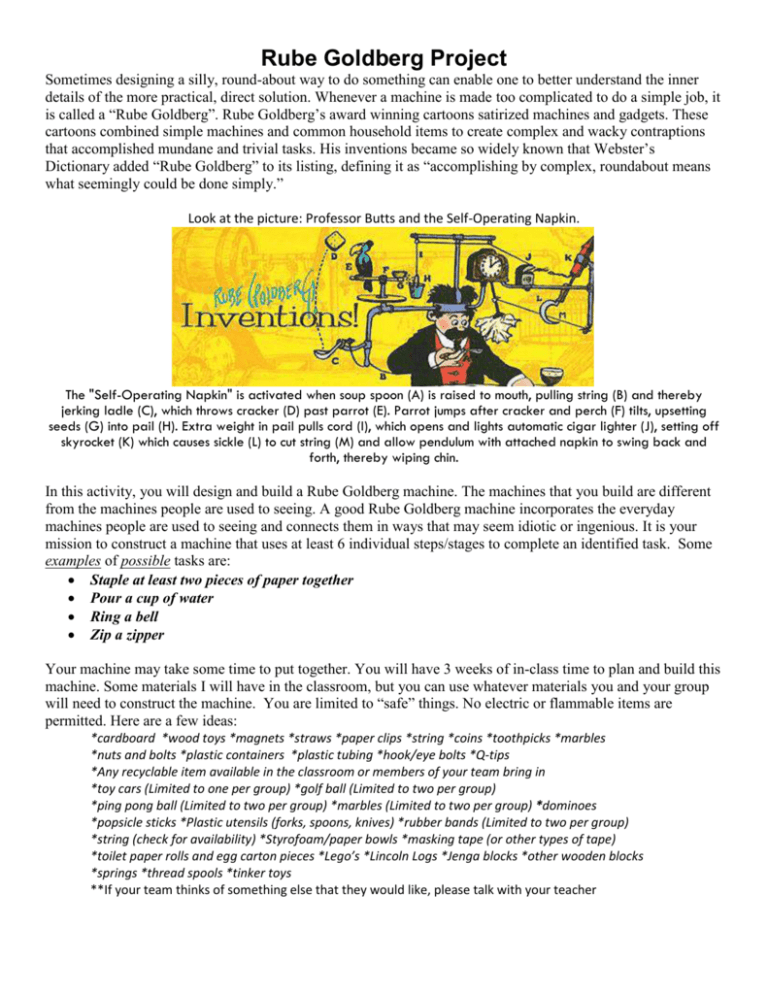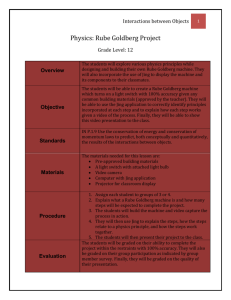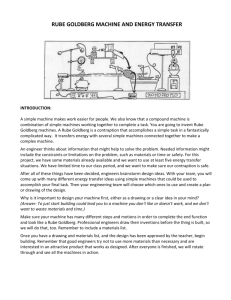Rube-Goldberg-Project
advertisement

Rube Goldberg Project Sometimes designing a silly, round-about way to do something can enable one to better understand the inner details of the more practical, direct solution. Whenever a machine is made too complicated to do a simple job, it is called a “Rube Goldberg”. Rube Goldberg’s award winning cartoons satirized machines and gadgets. These cartoons combined simple machines and common household items to create complex and wacky contraptions that accomplished mundane and trivial tasks. His inventions became so widely known that Webster’s Dictionary added “Rube Goldberg” to its listing, defining it as “accomplishing by complex, roundabout means what seemingly could be done simply.” Look at the picture: Professor Butts and the Self-Operating Napkin. The "Self-Operating Napkin" is activated when soup spoon (A) is raised to mouth, pulling string (B) and thereby jerking ladle (C), which throws cracker (D) past parrot (E). Parrot jumps after cracker and perch (F) tilts, upsetting seeds (G) into pail (H). Extra weight in pail pulls cord (I), which opens and lights automatic cigar lighter (J), setting off skyrocket (K) which causes sickle (L) to cut string (M) and allow pendulum with attached napkin to swing back and forth, thereby wiping chin. In this activity, you will design and build a Rube Goldberg machine. The machines that you build are different from the machines people are used to seeing. A good Rube Goldberg machine incorporates the everyday machines people are used to seeing and connects them in ways that may seem idiotic or ingenious. It is your mission to construct a machine that uses at least 6 individual steps/stages to complete an identified task. Some examples of possible tasks are: Staple at least two pieces of paper together Pour a cup of water Ring a bell Zip a zipper Your machine may take some time to put together. You will have 3 weeks of in-class time to plan and build this machine. Some materials I will have in the classroom, but you can use whatever materials you and your group will need to construct the machine. You are limited to “safe” things. No electric or flammable items are permitted. Here are a few ideas: *cardboard *wood toys *magnets *straws *paper clips *string *coins *toothpicks *marbles *nuts and bolts *plastic containers *plastic tubing *hook/eye bolts *Q-tips *Any recyclable item available in the classroom or members of your team bring in *toy cars (Limited to one per group) *golf ball (Limited to two per group) *ping pong ball (Limited to two per group) *marbles (Limited to two per group) *dominoes *popsicle sticks *Plastic utensils (forks, spoons, knives) *rubber bands (Limited to two per group) *string (check for availability) *Styrofoam/paper bowls *masking tape (or other types of tape) *toilet paper rolls and egg carton pieces *Lego’s *Lincoln Logs *Jenga blocks *other wooden blocks *springs *thread spools *tinker toys **If your team thinks of something else that they would like, please talk with your teacher The following items are NOT permitted: Electronics, batteries, dangerous chemicals, and other unsafe items Power tools other than glue guns are not to be brought to school You may not use more than one part of the game “Mousetrap” Points will be subtracted if there is not diversity in your building materials (for example, your entire machine should not be built from Legos) Rube Goldberg Project Guidelines GUIDELINES FOR BUILDING YOUR MACHINES: 1. Your machine must fit inside a space 2 feet by 2feet. The size restriction is because the machines must be small enough to be stored in the classroom. 2. A Rube Goldberg Machine is designed such that a single action starts the machine, such as pressing a button, letting go of a marble, cutting a string, removing a barrier, etc. No other additional human actions are required once your machine has started. 3. Your machine must have a minimum of six connected steps/stages, and must include: One object that must raise at least 35 cm by your machine At least three of the six simple machines (lever, screw, gear or wheel and axle, pulley, inclined plane, wedge). For a machine to count, it must do WORK (move something up or forward) DEFINITION OF A STEP: A single step is defined as a transfer of energy, or 1 cause through 1 effect. o EXAMPLES OF STEPS: 1. Ball rolls down a ramp and springs a mousetrap 2. The mousetrap pulls a string causing a scissors to cut 3. The scissors cut a cord, causing a weight to fall 4. Weight drops on tin foil, causing light bulb to turn on. Your machine should run smoothly all the way through. You will be penalized 5 points EACH TIME you interact with your machine after its initial start, for up to 15 points lost. 4. Your project must have a minimum running time of 10 seconds, and a maximum run time of 3 minutes. 5. Your machine must have a theme. EX: a favorite movie, animal, a room in your house, something science related, etc. Extra Credit: Up to 15 points of extra credit may be awarded for projects that exceed the requirements by using all six simple machines and/or an exceptional theme that goes above and beyond GUIDELINES FOR PRESENTING YOUR MACHINES: If your machine fails to work on its first graded attempt, you are allowed one free restart, which must occur within five minutes of the first run. Each group will do a PowerPoint or Video presentation to the class of their device AFTER they run the machine. Your presentation should include: A. Machine Strategy – 10 pts 1. Discuss how you came up with your ideas. 2. How did your ideas change during the project? B. Machine Design – 10 pts (use photos!) 1. What are the energy transfers (steps)? 2. What simple machines are used? C. Team Strategy and Accomplishments – 10 pts 1. What were the different jobs on your team? 2. Did you work together well? How did you solve differences of opinion? 3. What is each member most proud of? Deadlines/Due Dates Monday, February 3rd at the end of class – Cartoon in Rube Goldberg Style – Diagram/drawing and written explanation of machine is due. Tuesday, February 18th at the end of class - Rube Goldberg machine should be complete. What Makes a Good Rube Goldberg Machine? * The machine works. A Rube Goldberg Machine is designed such that a single action starts the machine running (pressing a button, letting go of a marble, cutting a string, removing a barrier, etc.), and no other human actions are required. * Rube Goldberg Machines have a unifying theme. Examples of good themes include the Wizard of Oz, Star Trek, food, farm equipment, gardening, sports, etc. * No group is penalized for having electrically or chemically powered steps, however mechanical steps are more in the spirit of Rube Goldberg’s machines. * It has clearly visible steps. On many machines, it is hard to follow all the steps. Teachers appreciate machines that are laid out so that as many of the steps as possible are clearly visible in linear sequence. (A hits B, B triggers C, C cuts D, etc.) * Rube Goldberg Machines make you smile. The best machines use common objects in ways you would not expect, for example RUBE GOLDBERG PROJECT GRADING SCORESHEET Group: Rube Goldberg Cartoon Grade Cartoon is clearly drawn with steps of machine clearly numbered/identified Written explanation clearly identifies the end task, each step includes cause/effect, simple machines and their relationship to the steps are identified SUBTOTAL: _________ (10 pts.) _________ (15 pts.) _________ (25 pts.) Rube Goldberg Machine Grade Meets size requirements (2 feet x 2 feet) Machine completes specified task Meets time requirements (10 sec-5 min) Machine has at least 6 distinct steps (5 pts. each) At least three simple machines are clearly represented and directly involved (5 pts. each) An object is elevated at least 35 cm by your machine Has a theme Extra Credit: Project includes more than 3 types of simple machines Theme goes above and beyond – exceptional! SUBTOTAL: _________ ( 5 pts.) _________ (10 pts.) _________ ( 5 pts.) _________ (30 pts.) _________ (15 pts.) _________ ( 5 pts.) _________ ( 5 pts.) _________ (+10 max) _________ (+ 5 max) _________ (75 pts.) Presentation A. Machine Strategy _________ (10 pts.) 1. Discuss how you came up with your ideas. 2. How did your ideas change during the project? B. Machine Design – (use photos!) _________ ( 10 pts.) 1. What are the energy transfers (steps)? 2. What simple machines are used? C. Team Strategy and Accomplishments _________ (10 pts.) 1. What were the different jobs on your team? 2. Did you work together well? How did you solve differences of opinion? 3. What is each member most proud of? D. Quality of Presentation _________ (20 pts.) 1. Quality of PowerPoint/keynote – 10 pts 2. Quality of accompanying verbal presentation – 10 pts SUBTOTAL: _________ (50 pts.) TOTAL: _________ (150 pts.)






